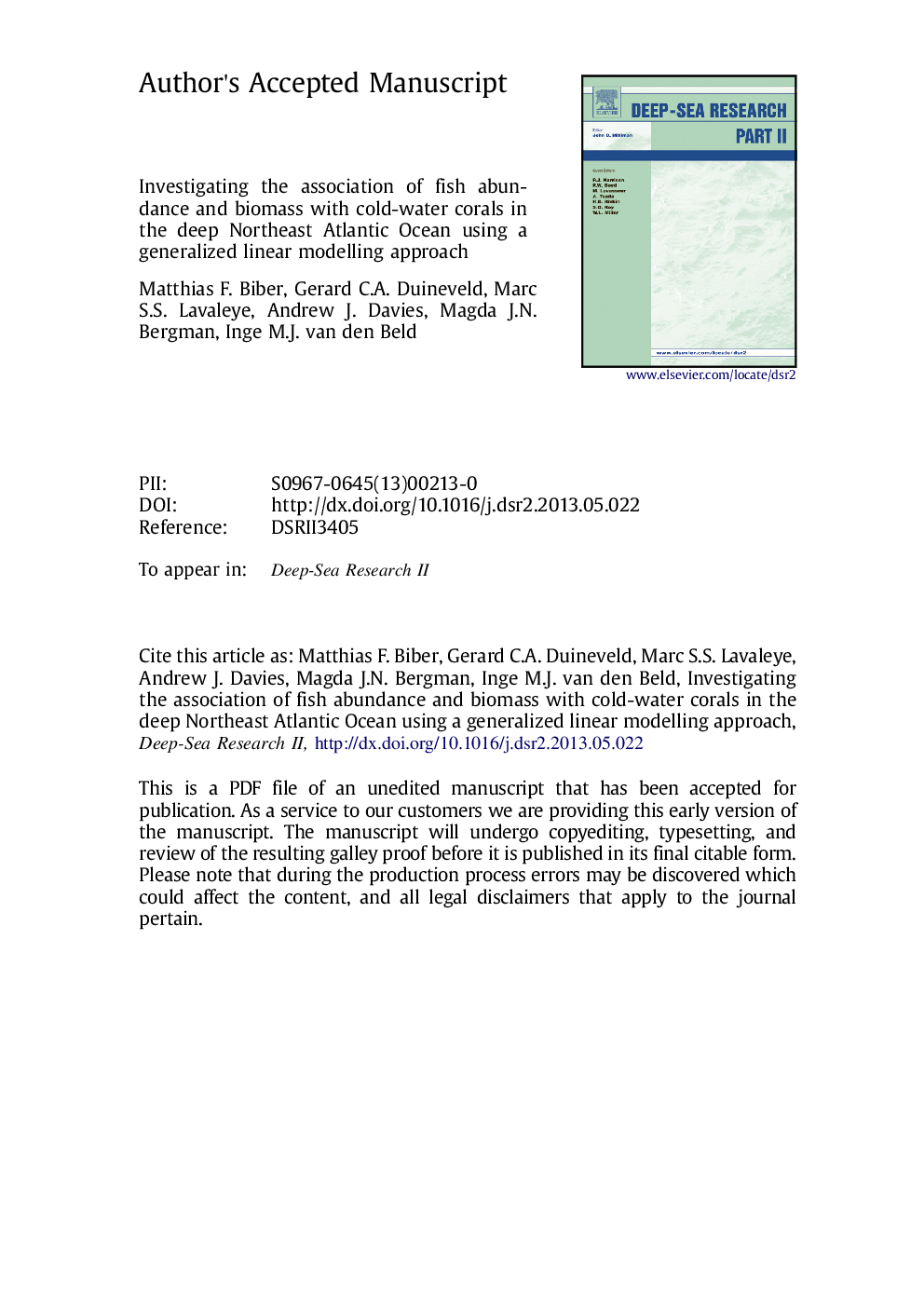| کد مقاله | کد نشریه | سال انتشار | مقاله انگلیسی | نسخه تمام متن |
|---|---|---|---|---|
| 6384270 | 1626441 | 2014 | 35 صفحه PDF | دانلود رایگان |
عنوان انگلیسی مقاله ISI
Investigating the association of fish abundance and biomass with cold-water corals in the deep Northeast Atlantic Ocean using a generalised linear modelling approach
ترجمه فارسی عنوان
بررسی رابطه فراوانی ماهی و زیست توده با مرجان های سرد آب در اقیانوس اطلس عمیق شمال شرقی با استفاده از یک رویکرد مدل سازی خطی
دانلود مقاله + سفارش ترجمه
دانلود مقاله ISI انگلیسی
رایگان برای ایرانیان
کلمات کلیدی
موضوعات مرتبط
مهندسی و علوم پایه
علوم زمین و سیارات
زمین شناسی
چکیده انگلیسی
Cold-water corals (CWC) can form complex three-dimensional structures that can support a diverse macro- and megafaunal community. These reef structures provide important biogenic habitats that can act as refuge, feeding, spawning and nursery areas for fish. However, quantitative data assessing the linkage between CWC and fish are scarce. The North Atlantic Ocean is a key region in the worldwide distribution of Lophelia pertusa, which is thought to be the most widespread frame-work forming cold-water coral species in the world. This study examined the relationship between fish and CWC reefs in the northeast Atlantic Ocean by means of video and remotely sensed data from three different CWC communities (Rockall Bank, Hatton Bank and the Belgica Mound Province). Using a tethered camera system, 37 transects were recorded during a period of 8 years. Fish-coral association was investigated using a generalised linear modelling (GLM) approach. Overall, Lepidion eques was the most abundant fish species present (143 ind. haâ1). Other common species were Sigmops bathyphilus (17 ind. haâ1), Synaphobranchus kaupii (15 ind. haâ1), Helicolenus dactylopterus (16 ind. haâ1) and Mora moro (7 ind. haâ1). The highest fish biomass was measured for Lophius piscatorius (26.3 kg haâ1). Other species with a high biomass were Helicolenus dactylopterus (4.3 kg haâ1), Lepidion eques (13.2 kg haâ1) and Mora moro (7.8 kg haâ1). Overall, no significant difference in fish abundance and biomass was found at coral framework habitats compared to non-coral areas. The relationship between fish and coral framework varied among fish species and study site. Fish count and length modelling results showed that terrain variables explain a small proportion of the variation of our data. Depth, coral-framework and terrain rugosity were generally the most important explanatory variables, but this varied with species and study site.
ناشر
Database: Elsevier - ScienceDirect (ساینس دایرکت)
Journal: Deep Sea Research Part II: Topical Studies in Oceanography - Volume 99, January 2014, Pages 134-145
Journal: Deep Sea Research Part II: Topical Studies in Oceanography - Volume 99, January 2014, Pages 134-145
نویسندگان
Matthias F. Biber, Gerard C.A. Duineveld, Marc S.S. Lavaleye, Andrew J. Davies, Magda J.N. Bergman, Inge M.J. van den Beld,
